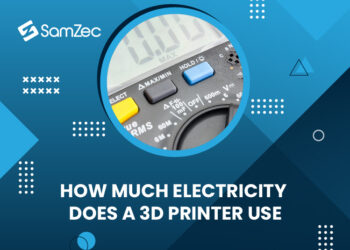As a hobby, 3D printing is becoming increasingly famous. 3D printers have dropped in price to the point where almost anyone can afford one. Many new 3D printer owners are interested in finding out how much can you print with 1kg Of filament. A 1 kg spool of filament can print nearly 1 kg of pieces because 3D printing with filament is a direct transfer system. There is a small percentage of loss between printing the pieces and loading the filament. The size and complexity of the pieces determine the number of pieces you can print on a 1 kg spool of filament.
There are a few ways to figure out how much filament you’ll need to 3D print an object. We’ll go over which of these methods is the most accurate, as well as which of them makes use of the software that controls your printer.
The Direct Calculation Method
The direct method is the simplest and most straightforward way to determine how much can you print with 1kg Of filament. The direct method does not necessitate a lot of math.
The direct method must be used to print and weigh one example of your project piece. Based on the weight of the finished piece, you can easily calculate the number of pieces you’ll get from a 1Kg spool of filament. Allow the software to handle the bulk of the work.
Let the Software do the Work.
Most slicing software will calculate the finished project’s weight or the amount of filament required to complete it.
Knowing how much filament you’ll need, either in terms of weight or length, will help you figure out if you have enough on a used spool to finish the project. For projects that require more than one spool of filament, there are ways to connect them.
Estimate the Volume and Do the Math
If you’re working on a solid project, you can estimate the volume of the piece and use that to figure out how much filament you’ll need. More math can be used to determine the length of the filament used to make the model, based on its diameter.
This method does not work well with 3D projects that have a lot of openings or voids, as well as those that are irregular in shape and size. For most people, estimating the volume of a model’s solid parts is nearly impossible.
What is “Slicer” Software
The majority of 3D objects for 3D printing are created with CAD software that permits realistic 3D modeling. However, even if the model design is finished, it is not yet ready to print on your 3D printer.
A slicer is a specialized software application that breaks down a 3D rendering into a series of slices of the model. These slices instruct the 3D printer as to where material should be placed and where it should not be placed. The slicer file is the one in charge of printing. This blog is the best way to get information if you want to know how much can you print with 1kg of Filament.
During the printing process, the Slicer software sends a lot of data to the 3D printer. The slicer file instructs the 3D printer on how to print.
- What route should I take during the printing process?
- What printing speed should I use?
- How thick should the material be laid down?
- Tolerances required for the finished project
Are There Ways to Use Less Filament?
There are a variety of ways to improve the efficiency of your 3D printing filament.
- Your model’s size should be reduced.
- Whenever possible, make hollow models.
- Support structures should be reduced or eliminated.
- Save your waste filament and put it to good use.
Model Size – Bigger Means More
Take a look at the size of your model. Let’s take a look at a cube with 10mm in each dimension. The cube’s volume is 1000 mm3. The volume of the cube is now 512 mm3 if each dimension is reduced to 8 mm. A material savings of 488 mm3 is achieved by reducing each dimension by 2mm. Material savings are estimated to be around 49%.
Do You Need a Solid Model?
Take a look at the cube from the previous example. We might be able to make a hollow model if we don’t need a solid model. We can remove a block of material from the model that is 6 mm on each side if we make each of the model’s walls 1 mm thick.
The amount of material saved by hollowing out the model is 216 mm3. The total volume of filament required to make this model has now been reduced to 296 mm3. This represents a nearly 70% reduction in cost when compared to the original 10 mm cube.
Support Structures Equal Waste
During the printing process, complicated models frequently require support structures. After the printing is finished, the support structures are removed, resulting in waste. There are a number of methods for removing or reducing support structures.
Overhang angles greater than 45 degrees often necessitate the use of support structures during the printing process. The majority of slicer programs use algorithms to determine when and where support structures should be added to a model. During printing, reducing or eliminating angles greater than 45 degrees can reduce the number of support structures.
Split the model – In some cases, splitting your model into two or more pieces is more cost-effective than building it all at once. Supporting structures are often unnecessary when your model is split into two or more parts.
Modify the slice file – For the most advanced users, this is an option. Slicer programs are notorious for being conservative when estimating a model’s requirements. Conservative designs ensure a successful print while ignoring the cost of filament. Users with a lot of experience may want to change the slice file and remove some support structures. This, however, is risky and may result in the print failing miserably.
Save that Waste Material – Become a Recycler
Small filament extrusion machines are purchased by some heavy users of their 3D printers, particularly those who print complicated models with a lot of support structures. The used filament can be recycled.
Small home-sized filament recycling machines are available for purchase, or you can download the instructions and files to print and build your own. Filament users who use a lot of it can save a lot of money over time.
Choosing the Type of 3D Printer can Save Filament
3D printers are available in a variety of styles and types. The three most popular are as follows:
- Printers that use FDM filament
- Resin SLA printers
- Printers that use SLS powder
Spools of filament for FDM filament printers are significantly less expensive than SLA resins or SLS powders. The difference could save you a lot of money on your models.
In addition, instead of using a solid infill like SLA or SLS printers, FMD printers reduce filament usage on solid models by creating internal infill areas that use only 25% of the material.
An FDM filament printer is a much better choice for most home and hobby 3D print enthusiasts, and it is much more cost-effective to operate in the long run.
Conclusion
How much can you print with 1kg Of filament is determined by the factors discussed in this article? People who print more objects in a given amount of time use more filament than those who print fewer 3D objects in the same amount of time.
Other factors to consider include the size of your 3D prints and how often you use your 3D printers.




















